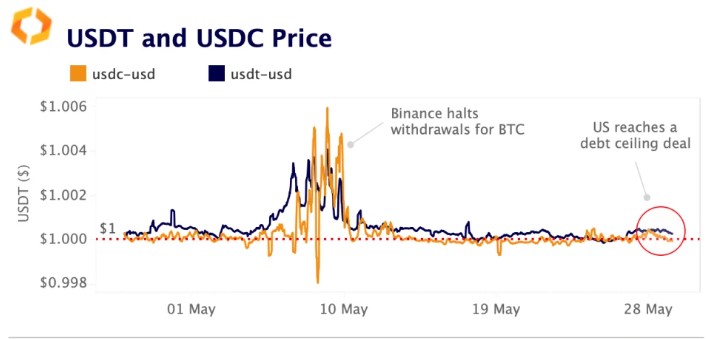Tether (USDT) is the largest stablecoin in the market, with a market cap of over $86 billion as of May 2023. Despite concerns about the current state of the cryptocurrency market, Tether has continued to dominate the stablecoin space, with supply growing significantly since early 2023. However, there are signs that new competitors may challenge its dominance in the future.
USDT’s reign over?
According to according to DeFiance Capital researcher and founder ArthurOx, one factor that may limit Tether’s growth is the emergence of new stablecoins. As investors become more concerned about the risks associated with Tether, they are likely to look for alternatives that offer more transparency and accountability.
For example, USDC (USD Coin) is a stablecoin backed entirely by US dollars held in reserve by regulated financial institutions, and its supply has grown rapidly in recent years.
Another factor that may limit Tether’s growth is the rise of decentralized stablecoins. These stablecoins are built on blockchain platforms and offer a decentralized alternative to centralized stablecoins like Tether.
Decentralized stablecoins eliminate the need for a central authority to manage the reserves, as the reserves are held in smart contracts on the blockchain. This provides a high degree of transparency and security and eliminates the risk of a central authority mismanaging reserves or engaging in fraudulent activities.
An example of a decentralized stablecoin is DAI, built on the Ethereum blockchain. DAI is backed by a basket of cryptocurrencies held in smart contracts on the blockchain. This ensures that the value of DAI remains stable while providing a high level of transparency and security.
In addition to these factors, there are also regulatory risks associated with Tether. The stablecoin has come under scrutiny from regulators in the US and other countries, with some calling for greater transparency and oversight. If regulators impose stricter regulations on Tether, it could limit its growth and provide opportunities for other stablecoins to gain market share.
Tether and USDC Show Resilience Amid US Debt Ceiling Drama
According to a recent report by Kaiko, USDT and USDC showed little volatility amid the ongoing US debt ceiling drama. Despite concerns about a possible US default, USDT and USDC have seen little to no price movement over the past two weeks. This suggests that the markets did not view default as the base case and that investors remained confident in the stability of these stablecoins.

Interestingly, USDT and USDC increasingly traded together during periods of market stress. For example, when Binance temporarily halted withdrawals for Bitcoin (BTC) earlier this month due to network congestion issues, both stablecoins surged above $1, as shown in the chart above. This suggests that the USDC may have gained some appeal as a safe haven asset as US banking problems eased.
The resilience of USDT and USDC during the debt ceiling drama reflects a broader trend in the cryptocurrency market, where stablecoins have become an increasingly popular way for investors to hedge against volatility.
These developments underscore the growing importance of stablecoins in the cryptocurrency ecosystem. As more investors look to hedge against market volatility and regulatory uncertainty, demand for stablecoins is likely to increase. In addition, the emergence of new decentralized finance (DeFi) applications that require stablecoins as a medium of exchange and collateral is also driving demand.
Featured image of Unsplash, chart from TradingView.com

